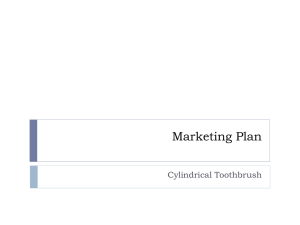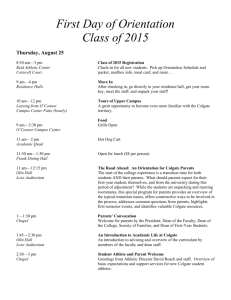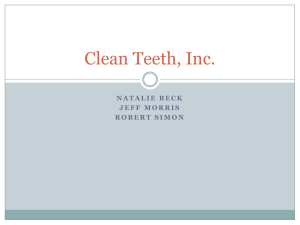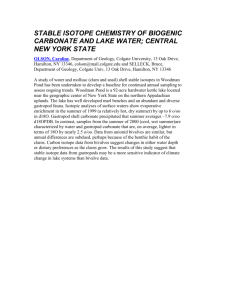COLGATE - Lea Pernet
advertisement
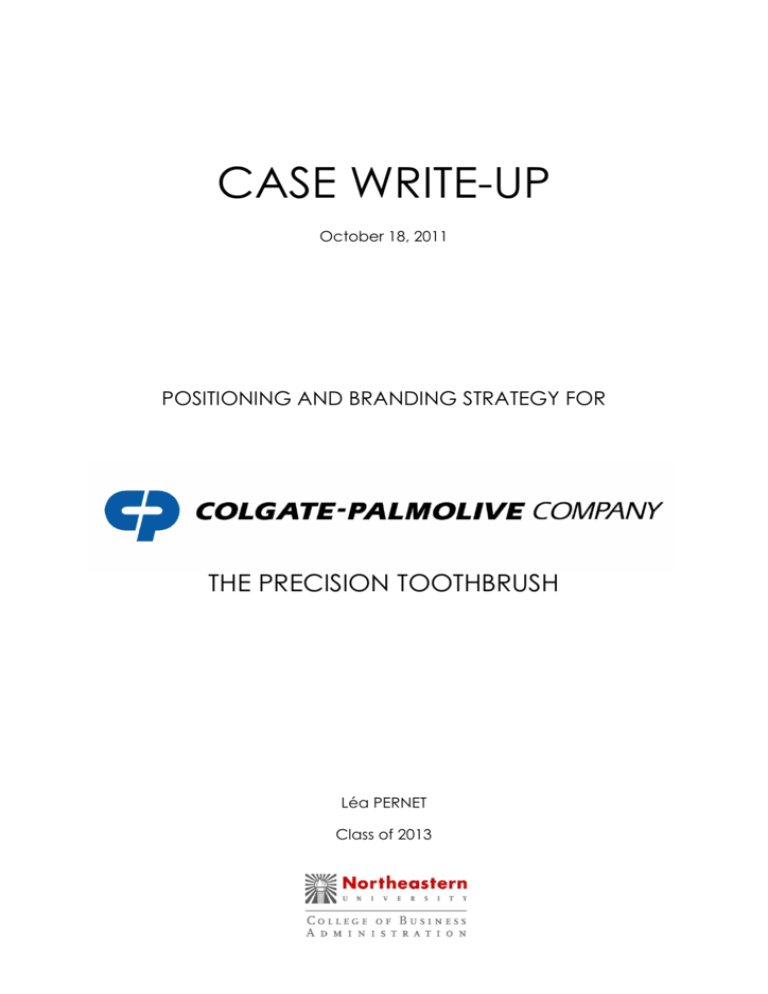
CASE WRITE-UP October 18, 2011 POSITIONING AND BRANDING STRATEGY FOR THE PRECISION TOOTHBRUSH Léa PERNET Class of 2013 0 TWO STRATEGICAL ISSUES IN A COMPETITIVE SUPER-PREMIUM MARKET Colgate-Palmolive’s products are present both in the Professional and the Value segments of the U.S. toothbrush market. After over three years of research, ColgatePalmolive (CP) is ready to enter the third segment –the “super-premium” U.S. toothbrush market- with its new top of range product, the Precision in early 1993 . Over the past two years, the super-premium market –dominated by Oral-B- has witnessed the arrival of new competitors with innovative featured toothbrushes. CP’s triple-action toothbrush is therefore facing a highly competitive market; thus implying extremely challenging and crucial issues in terms of positioning and branding strategy. It has been argued whether the Precision should be positioned as a niche toothbrush, targeted to consumers concerned about gum diseases; or as a mainstream product, marketed as the most effective in the market. The second issue concerns the branding strategy. While some executives argue that stressing the brand by calling the toothbrush “Colgate Precision” would build the brand equity, other believe that underlining the name of the product -as opposed to the brandcalling it “Precision by Colgate” would limit the effects of cannibalization. A STRATEGY IN TWO STEPS: FROM NICHE TO MAINSTREAM First of all, CP should launch its Precision as a niche product targeted to therapeutic brushers concerned about gum diseases. The company should then move to a mainstream strategy after one or two years. Second of all, the branding strategy should emphasize the brand’s name and opt for “Colgate Precision” as a name for its product. 1 ANALYSIS Internal Analysis: Progressively Gaining the Professional Distribution CP holds the first position in the U.S. retail toothbrush market, but the company is new in the super-premium segment; its Precision’s name should therefore emphasize the brand, in order to use its current brand equity to build trust and credibility. CP’s main weakness with the mainstream approach is that it could result in stock out costs in 1993. Therefore, CP should launch its Precision as a niche and then switch to a mainstream strategy when it has built up enough stock of the product. Diversification Strategy: Maximization of Colgate-Palmolive’s overall net profits By introducing a new product into the super-premium market, CP uses a diversification strategy. The risk taken must reflect the possible profitability. Both the mainstream and the niche strategy imply that the break-even of the product is reached in 1994 (see Exhibit 2). Taking into account the cannibalization effects, the analysis of the overall net profits of CP Toothbrushes highlights a profit from 1993 with a niche positioning –even in the worse case cannibalization scenario- while a mainstream strategy would imply a loss in the worse case scenario (see Exhibit 3). On the other hand, a mainstream strategy has a better impact on net profits in 1994 than a niche strategy. External Analysis: Entering the dentist distribution channel A mainstream strategy implies 8MM unit sales through professionals and 3MM with a niche strategy. Known as the “dentist’s toothbrush”, Oral-B is leader on the professional market. CP’s main weakness is its lack of dentist distribution, the company needs to introduce its Precision in 1993 to dentists as a niche targeted for a precise market (consumer concerned about gum diseases) to make its place through 2 this distribution channel. CP will then be able steal market share more aggressively by implementing it as a mainstream when the product has been tested. Target Market Behavior: Reach Therapeutic and Cosmetic Brushers Generally, consumers have a growing trend of choosing a brush to fit their individual needs over than price, CP can therefore chose niche strategy with a higher price if the product responds to a specific need. The two kinds of involved oral health consumers -the therapeutic and cosmetic brushers- use super-premium and professional toothbrushes. The therapeutic brushers are concerned about functional effective products such as baby-boomers -30 to 55 years old- who have an increased interest in gum health. Consumers chose a brush to fit their individual needs over than price. Entering the super-premium market as niche with a distinctive unique selling proposition will therefore capture this part of the market and build a professional and reliable image of the Precision. Secondly, the cosmetic brushers, who already use two of CP’s SKUs, will most probably be favorable to the Precision when it enters the mainstream approach with a more global message of effectiveness. Moreover, both the therapeutic and cosmetic brushers use super-premium and professional toothbrushes. Being present in the professional segment, CP should choose “Colgate Precision” to reach the super-premium segment. Competitive Advantage: Efficient Positioning for a Presence on the Whole Market As highlighted in Exhibit 4, both the niche and the mainstream strategy enable CP to significantly differentiate itself from its competitors in the super-premium market. However, Oral-B dominates this market with two products; therefore CP needs to enter it with a clear technical differentiation. Opting for a niche strategy for launching Precision will make Precision the super-premium toothbrush for therapeutic brushers 3 that prevent from gum diseases thanks to its three different length bristles. CP will need this unique selling proposition to acquire a valuable place in this segment. In 1994, boosted by this reputation, CP will be able to reach the overall therapeutic and cosmetic brushers with a more global position as the super-premium toothbrush for consumers involved in oral health that provides the most efficient oral clean-up thanks to its triple-action brush. CONCLUSION In order to maximize its profits and avoid any stock out costs, CP should launch its Precision in the super-premium segment with a niche positioning targeting consumer concerned about gum diseases. The use of the branding “Colgate Precision” will not only ensure a better introduction in the dentist distribution channel, but also a better brand equity to enter the mainstream approach. Indeed after having conquered the niche market, CP’s reputation in the super-premium segment will be strong enough to reach the mainstream market. In both positions, CP will benefit from its product’s innovative feature to differentiate itself efficiently from its competitors. 4 EXHIBIT 3: Complete SWOT Analysis STRENGTHS - CP is the global leader in household and personal care products: financial stability - A team of 170 researchers developed an effective product: triple action can achieve a 50% increase of plaque removal at the gum line and in-between the teeth - CP’s Oral Care held 16% of the world toothbrush market in 1991. - CP holds the first position in the U.S. retail toothbrush market (23.3% of volume share). WEAKNESSES - Low media expenditures and share voice compared to competition. - Not the most recommended brand by dentists. - Possible inability to produce enough stock of Precision to meet demand in a mainstream strategy. OPPORTUNITIES - Increase of new products: new performance benefits have become more important purchase criteria (not only the price anymore). - Consumers’ growing purchase frequency. - From late 80s: emergence of a “super-premium” sub-category of toothbrushes (35% of unit volume and 46% of $ sales in the U.S. in 1992). - Gum protection awareness: rapid growth of soft and extra soft bristle toothbrushes market share (above 7% a year). - Baby boomers: growing concern of gum health (as opposed to cavity prevention), willing to pay premium for those features. - Consumer not familiar with prices for toothbrushes. - Proper brushing is seen as key to the prevention of most dental problems (toothbrushes are considered as important as toothpaste to effective oral hygiene). - People replace brushes every 7.5 months; however 48% claim they replace it every 3 months (recommended by dentists): people are informed and concerned about their oral hygiene but don’t have the proper behavior yet. - 65% consumers have more than 1 toothbrush. - 87% consumers are involved oral health consumers. - 46% consumers are therapeutic brushers that search out functionally effective products - Therapeutic consumers already use Colgate products (Colgate Plus) (but Oral-B is their main used brand). - CP toothbrush line hold 25% to 40% of the category shelf in most stores. - 22% of toothbrushes are expected to be sold through dentists in 1992. THREATS - Growth in the sales of private label toothbrushes in the value segment. - Unit sales growth projected to slow down in 1993 because of increased sampling through dentists and 2for1 promotions: household inventory buildup. - Super-premium segment already has tough competition: P&G, J&J, Oral-B and SmithKline Beecham, total of 24 SKUs. - Low average replacement frequency: 7.5 months (vs 3 months recommended by dentists). - Low average purchase frequency: 11.6 months because of 2for1 promotions. - Consumers believe the main role of toothbrushes is food particles removal, plaque removal and gum stimulation is seen as secondary. - Only 3% of toothbrushes are impulse purchases. - Most therapeutic consumers buy Oral-B products (2 of their SKUs). - Oral B is the market leader since the 1960s and has strong reliable brand equity as “the dentist’s toothbrush” emphasized by their communication through “Rob the dentist”, they are competitive in the whole oral care market and announce they would increase the length of each of their product lines. - Increased competition implies increased consumer promotion costs. - Dentist distribution dominated by Oral-B. 5 EXHIBIT 2: Net profit Margin Analysis NICHE COSTS Professional Market REVENUE Market Retail Year 1 MAINSTREAM Year 2 Year 1 Year 2 Units Sold 8,000,000 15,000,000 26,800,000 44,100,000 Unit Price to Retailers $ 2.02 2.02 1.76 1.76 Net Retail sales $ 16,100,000 30,300,000 47,500,000 77,400,000 Units Sold 3,000,000 3,000,000 8,000,000 8,000,000 80% Units Sold 2,400,000 2,400,000 6,400,000 6,400,000 Unit Price to Dentists $ 0.79 0.79 0.79 0.79 Net sales $ 1,896,000 1,896,000 5,056,000 5,056,000 20% Units Solds 600,000 600,000 1,600,000 1,600,000 Unit Price to Dentists $ 0.95 0.95 0.95 0.95 Net sales $ 570,000 570,000 1,520,000 1,520,000 Net Professional Sales $ 2,466,000 2,466,000 6,576,000 6,576,000 Total Unit Sold 11,000,000 18,000,000 34,800,000 52,100,000 Total Net Sales $ 18,566,000 32,766,000 54,076,000 83,976,000 Manufacturer/unit cost $ 0.66 0.66 0.64 0.64 Cost of goods sold $ 7,260,000 11,880,000 22,272,000 33,344,000 Units of Promotion Sampling 2,000,000 2,000,000 7,000,000 7,000,000 Cost of sampling promotion 1,320,000 1,320,000 4,480,000 4,480,000 Advertising costs $ 11,200,000 11,700,000 32,800,000 29,000,000 Capacity costs 316,667 450,000 886,667 1,270,000 Total Costs $ 20,096,667 25,350,000 60,438,667 68,094,000 (1,530,667) 7,416,000 (6,362,667) 15,882,000 TOTAL NET PROFIT (before taxes) $ 6 EXHIBIT 3: Cannibalization Analysis There are no sales forecasts of Colgate Classic and Colgate Plus sales for 1993 and 1993. Therefore, the following cannibalization analysis was based on the 1992 income statement and the following assumptions: - Colgate Classic and Colgate Plus volume sales have been increasing by 14% in 1990, 10% in 1991 and 11% in 1992. The overall toothbrush U.S. market projected growth for 1993 is expected to be a little bit slower because of increased sampling and 2for1 promotions (increased household inventory). Therefore, the following analysis considers an average growth of 7% in volume in 1993 and 1994. - For Colgate Classic and Colgate Plus forecasts of 1993 and 1994, the cost of sales were kept at 49% of net sales, the total fixed overhead at 12% of the net sales and the total advertising costs at 27% of net sales; as it was in the 1992 income statement. - As there is 78,336,000 units sold in 1992 and $ 91,611,000 net sales, calculations have been done with an average unit price of $ 1.17 for Colgate Classic and Colgate Plus combined. - Forecasts for Colgate Precision are based on the net profit margin analysis (cf. EXHIBIT 1). Two scenarios of cannibalization have been considered: - Best scenario: Colgate Precision takes 35% in volume of Colgate Classic and Colgate Plus combined. - Worse scenario: Colgate Precision takes 60% in volume of Colgate Classic and Colgate Plus combined. 7 Net profit with Colgate Precision positioned as a niche 8 Net profit with Colgate Precision positioned as mainstream 9 EXHIBIT 4: Competition Positioning Map on the Super-Premium Market 10 Sources (images) http://partners.nbmbaa.org/ExhibitorList/Details/Default.aspx?ID=675 http://www.prweb.com/releases/Northeastern_University/International_Business http://www.greatestlogo.com/oral-b#.TpzYqd6Pbm0 http://www.yourlogoresources.com/johnson-johnson-logo/ http://all-free-download.com/free-vector/vector-logo/smithkline_beecham_1_129495.html 11
